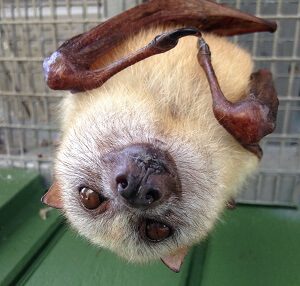How Much Does a Pet Bat Cost?
Last Updated on December 13, 2023
Written by CPA Alec Pow | Content Reviewed by ![]() CFA Alexander Popinker
CFA Alexander Popinker
Bats appeared 50 million years ago, and we now know over 1,300 species. Contrary to many people’s beliefs, bats don’t just feed on blood. Conversely, there are very few bats (specifically 3 species out of 1,300) that feed on blood. They live only in South America and feed on the blood of domestic animals. Other species of bats feed on fish, nectar, or fruit. But most species of bats, over 800, prefer to eat insects of all kinds: mosquitoes, moths, moths, beetles, spiders, and more.
It may be an exotic idea to some to own a pet bat, but these pets are illegal in the majority of the states of America and are considered to be endangered. In most cases, you will need to have a special rehabilitation license or a zoo if you want to own a pet bat. Moreover, the majority of bats are protected by many different laws.
How Much Does a Pet Bat Cost?
In general, you can expect to pay anywhere between $550 and $1,100 just to buy a pet bat. However, you should not be surprised to see some prices on the low end or high end. Also, it may be pretty hard to find a pet bat for sale because there are just a few breeders in the world. The cost of a pet bat is influenced by some factors such as your local regulations, the breed, your geographical location, and the genealogical history.
You might also like our articles about the cost of a pet ball python, a pet zebra, or a pet giraffe.
The easier bats to handle and take care of are the Egyptian fruit bats, so this is the most common breed kept as an exotic pet. There are ten species of fruit bats. The length of these bats is around five inches and their wingspan is around one and a half feet.
What are the extra costs to keep a bat as a pet?
Bats often gather in large numbers in a place, which can be a cave, the roof of an old building, or a hollow tree. All sleeping areas must be protected from predators, heat from the sun, low winter temperatures (hibernation beds), and rain. So, you will have to invest in building a conservatory and fill it with several bats to allow them to mate, and socialize. This will increase your costs but there is no other option if you want your pet bats to have a long life.
Also, bats tend to sleep during the day and be active during the night as these are nocturnal animals. So, you will have to invest in a large bat enclosure or an area where they can have space to fly.
If your state’s laws allow you to own a pet bat you will need a special permit for it and this is another cost you should consider.
As pet bats are not easy to find, you will need to purchase them online and pay an extra cost for the delivery fees.
You will have to also budget for the vaccination because bats can carry rabies, although rare.
As with any other pet, you will have to take into consideration the costs of the surprise/routine vet visits, accessories, and food. For example, you should budget for food, which consists of fruits, supplements, and biscuits, anywhere between $30 and $40 per month.
Compared to their body weight, bats eat the insect equivalent of 2/3 of their weight every night. Comparing the bat’s appetite with that of a human, a 60 kg person should eat about 40 kg of food daily!
Pet Information
 You can never transport a bat without a CDC license.
You can never transport a bat without a CDC license.
In case you love bats and you are not allowed to own one in the place where you are living, take into consideration talking with a local wildlife rehabilitation center to volunteer and work with them.
Bats are not usual pets and you would not be able to cuddle with them anytime you want as you would do with a puppy for example. These are exotic animals and hate to be handled; they can even bite you.
Bats live in colonies and are found all over the planet. The ability to fly allowed bats to travel and live in every corner of the globe except the Arctic and Antarctic.
Females can control the time of gestation and the birth of baby bats. To ensure optimal living conditions for the babies, bats are equipped with a variety of biological tactics that allow them to fertilize, implant, or delay the development of the fetus so that the birth time coincides with the period of food abundance or favorable environmental conditions.
Although many believe that bats cling to your hair, this is not true at all.
Bat droppings (called guano) are considered the best organic fertilizer (guano was considered the “oil of the 19th century”).
The largest bat in the world is the “flying fox”, which lives in the islands of the South Pacific. The wingspan of this species can reach 6 feet. The smallest bat in the world is the bumblebee, which lives in Thailand, is smaller than a nail, and weighs less than a coin.
More than half of the bat species in the United States are endangered. In addition to the changes their habitat is undergoing, many of them are dying of a condition called white-nose syndrome. It has affected species in both the United States and Canada.
While a dog or cat lives an average of 15-20 years, the lifespan of bats can reach 30 years. Who knows, maybe food made entirely of insects may even have its benefits.


Leave a Reply
Want to join the discussion?Feel free to contribute!